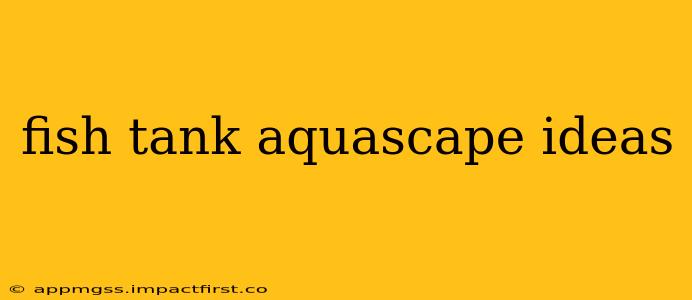Creating a stunning aquascape is more than just filling a tank with water and fish; it's about crafting an underwater world that captivates the eye and provides a thriving habitat for your aquatic companions. Whether you're a seasoned aquascaper or a beginner just starting out, this guide provides inspiration and practical advice for designing your perfect fish tank aquascape. We'll explore various styles, materials, and techniques to help you transform your aquarium into a breathtaking masterpiece.
What are some easy aquascape ideas for beginners?
For beginners, simplicity is key. Start with a basic hardscape foundation using rocks or driftwood arranged in a visually appealing way – perhaps a gently sloping hill or a single, prominent centerpiece. Avoid overcrowding, allowing ample space for swimming. Easy-to-care-for plants like Anubias or Java Moss are excellent choices, as they require minimal maintenance and thrive in various conditions. Focus on creating a clean, aesthetically pleasing layout rather than a complex, multi-layered design. A single focal point, like a beautifully shaped piece of driftwood or a cluster of vibrant plants, can make a huge impact.
What are the best plants for aquascaping?
Choosing the right plants is crucial for a successful aquascape. Consider factors like light requirements, growth rate, and the overall aesthetic you're aiming for. Popular choices for beginners include:
- Java Moss: Low-maintenance, versatile, and perfect for attaching to rocks or driftwood.
- Anubias: Slow-growing, hardy plants that tolerate low light conditions.
- Cryptocoryne: Another low-maintenance option that adds texture and visual interest.
- Sagittaria: Provides a nice contrast with its ribbon-like leaves.
For more advanced aquascapes, consider plants like Vallisneria (for a lush, grassy look) or various stem plants that add height and depth. Remember to research the specific needs of each plant to ensure they thrive in your aquarium's environment.
How do I choose the right substrate for my aquascape?
The substrate is the foundation of your aquascape, providing essential nutrients for your plants and influencing the overall visual appeal. Popular options include:
- Gravel: An inexpensive and readily available choice, available in various colors and sizes.
- Sand: Offers a more natural look and is ideal for certain plant types.
- Aquarium Soil: Enriched with nutrients, it promotes healthy plant growth.
The best substrate for your aquascape depends on your chosen plants and overall design. Research the specific needs of your plants before making a decision.
How do I create a natural-looking aquascape?
Achieving a natural look requires careful planning and execution. Study natural environments, paying attention to the way plants and rocks are arranged in nature. Use a variety of materials to create texture and visual interest. Avoid symmetrical layouts; instead, opt for asymmetrical arrangements that mimic natural formations. Consider incorporating elements like driftwood, rocks, and plants of varying heights and textures to create depth and visual appeal. The goal is to create a scene that looks as though it evolved organically, rather than being artificially constructed.
What are some popular aquascaping styles?
Several styles cater to different tastes and skill levels:
- Iwagumi: A minimalist Japanese style that emphasizes rocks and a few carefully chosen plants.
- Dutch Style: A densely planted style featuring a variety of plants arranged in a structured, organized manner.
- Nature Aquarium Style: Aims to replicate a specific natural ecosystem, such as a stream bed or a section of a rainforest.
Choose a style that aligns with your aesthetic preferences and skill level. Beginners may find the Iwagumi style easier to manage, while experienced aquascapers may prefer the complexity of the Dutch or Nature Aquarium style.
What are some advanced aquascape techniques?
Advanced techniques involve more complex hardscape designs, intricate plant arrangements, and CO2 injection systems for lush plant growth. Techniques like:
- Dry Start Method: Starting the aquascape out of the water to establish plants before adding water.
- CO2 Injection: Supplying extra carbon dioxide for optimal plant growth.
- Substrate fertilization: Using specialized substrates or fertilizers to nourish plants.
These techniques are best suited for experienced aquascapers with a solid understanding of plant and aquatic biology.
By carefully considering these factors and experimenting with different approaches, you can create a truly stunning and thriving fish tank aquascape that reflects your unique style and creativity. Remember to always research your chosen plants and fish to ensure compatibility and success.
